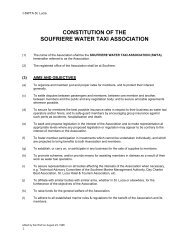WWF Cover photo - Soufriere Marine Management Association ...
WWF Cover photo - Soufriere Marine Management Association ...
WWF Cover photo - Soufriere Marine Management Association ...
You also want an ePaper? Increase the reach of your titles
YUMPU automatically turns print PDFs into web optimized ePapers that Google loves.
Goodridge et al. (1997) collected baseline data on the status of the Soufrière reef fishery at the time of theimplementation of the SMMA and during the early months of management. Roberts et al. (2001) compared thisinformation with data collected in 2000/1, after five years of effective management. They found significantincreases in total catches and catch per unit effort of reef fishers using the two main fishing gears – large trapsset overnight and small traps baited with fish and set for 1-2 hours (Fig 2). For big pots, mean catch per trip,catch per pot per trip and catch per hour at sea all increased significantly, whilst there was no significant changein the mean catch per day soaked for traps. For small traps mean catch per trip and catch per pot per tripincreased significantly, whilst there was no significant change in mean catch per hour fished. Catch per uniteffort increased by 46% for large traps and 90% for small traps. Since overall fishing effort was similar between1995/6 and 2000/1, Roberts et al. (2001) concluded that reserves had increased total reef fish landings abovelevels at the time of implementation of the reserves.In terms of catch composition, in the large pots the proportion of surgeonfish (Acanthuridae), snappers(Lutjanidae) and grunts (Haemulidae) increased. In small pots, which generally targeted smaller fish, there wasan increase in the proportion of groupers (Serranidae), squirrelfish (Holocentridae) and parrotfish (Scaridae)(Gell et al. in prep. b). In 2000/1 fishers caught over 100 species of fish from Soufrière’s reefs and snappers,parrotfish, squirrelfish, groupers and moray eels (Muraenidae) dominated catches. In the underwater surveys offish, snappers and parrotfish showed the clearest reserve effects, with rapid increases within the reserves,followed by increases in fishing grounds. The diverse range of exploited fish species showed a wide variety ofresponses to the closed areas, inside and outside the reserves (Gell et al. in prep. b). Some responded rapidly toprotection, others increased after a delay, and a few have not responded at all.12Fish biomass per count in kg108642FishedUnfished reserveReservesestablishedHurricaneLenny01995 1996 1997 1998 1999 2000 2001Figure 1: The mean biomass of commerciallyimportant fish per count in kilograms in fished andunfished areas of the SMMA from 1995 to 2001. Errorbars show +/- SE.One of the reasons for the success of the SMMA in terms of increasing reef fish catches is the network design,with four main areas of no-take reserve, interspersed with fishing priority and multiple-use areas. Most of themain fishing sites are reef areas where the reef is contiguous across no-take and fishing priority areas, providingcontinuous habitat across the protected-unprotected border. Fishers often place fish pots or fish with hook andline on the boundaries of the marine reserves, confirming the belief of many fishers that there are “better fishinside the marine reserves”.The reef fishers found the first couple of years of management difficult. They were unable to use some of theirbest fishing grounds and some had to travel further to reach fishing sites, which could be arduous consideringthat many lacked outboard engines, relying on oars, and currents can be strong. In 1997, after two years of76



